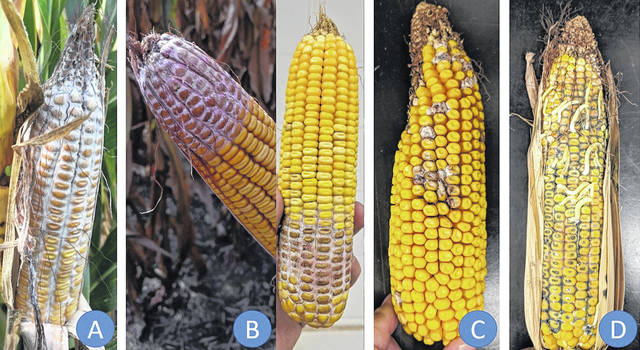
If you had damaged corn or were rejected at an elevator because your vomitoxin levels were too high, you are not alone. This was a widespread issue across Ohio. Vomitoxin is caused by Gibberella Ear Rot. Like with most ear rots, it is difficult to control because there has not been clear results on management strategies.
Harvest and hybrid management
Harvesting early is very important. While you cannot get rid of vomitoxin, getting the grain cooled down and dry can stop the spread. There is some indication that increasing the combine fan speed during harvest will help clean out the grain. This has worked in wheat. OSU will run a study this winter to fine tune this recommendation. Some hybrids are more resistant than others, but this often is not indicated by seed companies. If you have a hybrid that has not had issues in years when we have seen high instances, you may want to stick with that one. On the other hand, if you had a hybrid that was really bad this year, it may be more susceptible.
Fungicide management
Some fungicide studies have been conducted but it has been difficult to draw conclusions because of the variability of disease across the field. One thing is evident and that is traditional aerial applications are not as effective because the fungicide needs to reach the silks. Studies using drop nozzles to the silking level, applied at silking, were the most effective. Prothioconazole showed positive results. Headline Amp and Miravis Neo also showed decent reductions in a one-year study. Other fungicides such as Headline, Miravis Ace and Proline showed reductions, though not as great. Everything is very preliminary so there is no strong recommendation at this time.
Ear rot details
There are four different ear rots we commonly see in Ohio: Fusarium, Gibberella, Diplodia and Trichoderm. These four thrive in 59-86 degrees which we commonly have here in Ohio during the growing season. Gibberella is the only one that produces vomitoxin. This is confusing because fusarium head blight (scab) can produce vomitoxin in wheat. You can thank plant pathologists for that one. Gibberella appears as a pink to white fungal growth. It is usually at the tip of the ear but can also occur at the bottom of upright hybrids.
Fusarium in corn produces fumonisin which can be toxic, especially to horses, but is not a concern for beef or poultry. It appears on individual or groups of kernels throughout the ear. Diplodia is one I see most often and appears as a thick white to gray mold starting at the tip or bottom of the ear. No known mycotoxins are associated with this disease. Trichoderma is identified by the green colored fungal growth and can cause premature germination. Mycotoxins are generally not a major concern. While these three do not produce vomitoxin, they can reduce yield and test weight so it is still important to prevent occurrences.
For all diseases, there are three things needed for them to occur: the host, the inoculum, and favorable conditions. Removing one of these will prevent the disease. Favorable conditions are out of our control. Modifying your approach to the host and inoculum can help but we do not have good information on hybrid resistance or even fungicide applications. Crop rotation is encouraged to remove the host. Burying residue can reduce inoculum that survives through the winter.
For more information on ear rots and vomitoxin, go to AgCrops.osu.edu and search “ear rot.”


